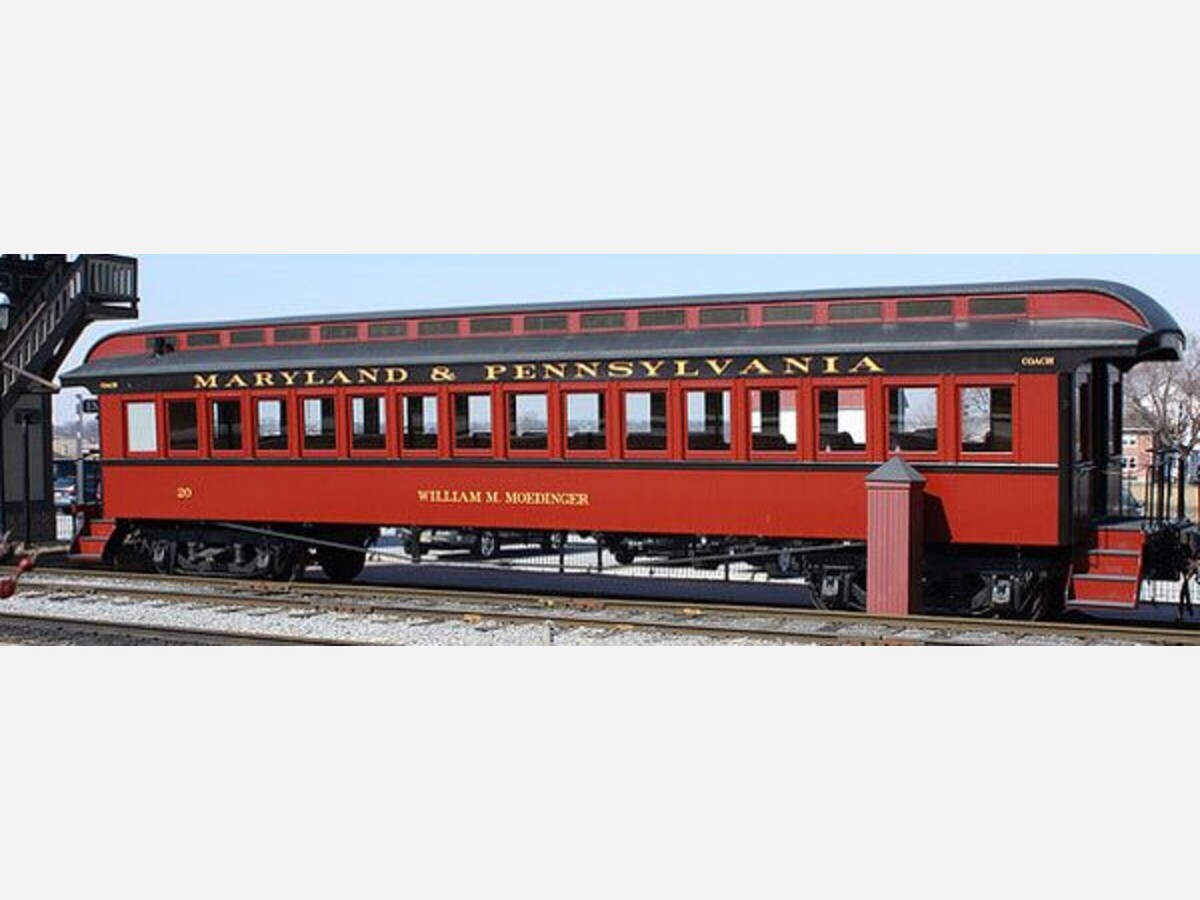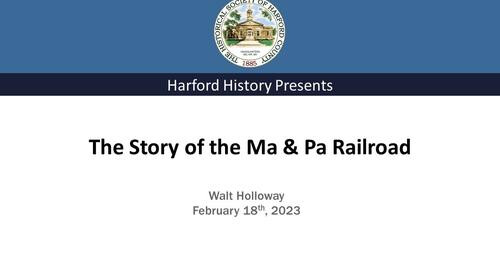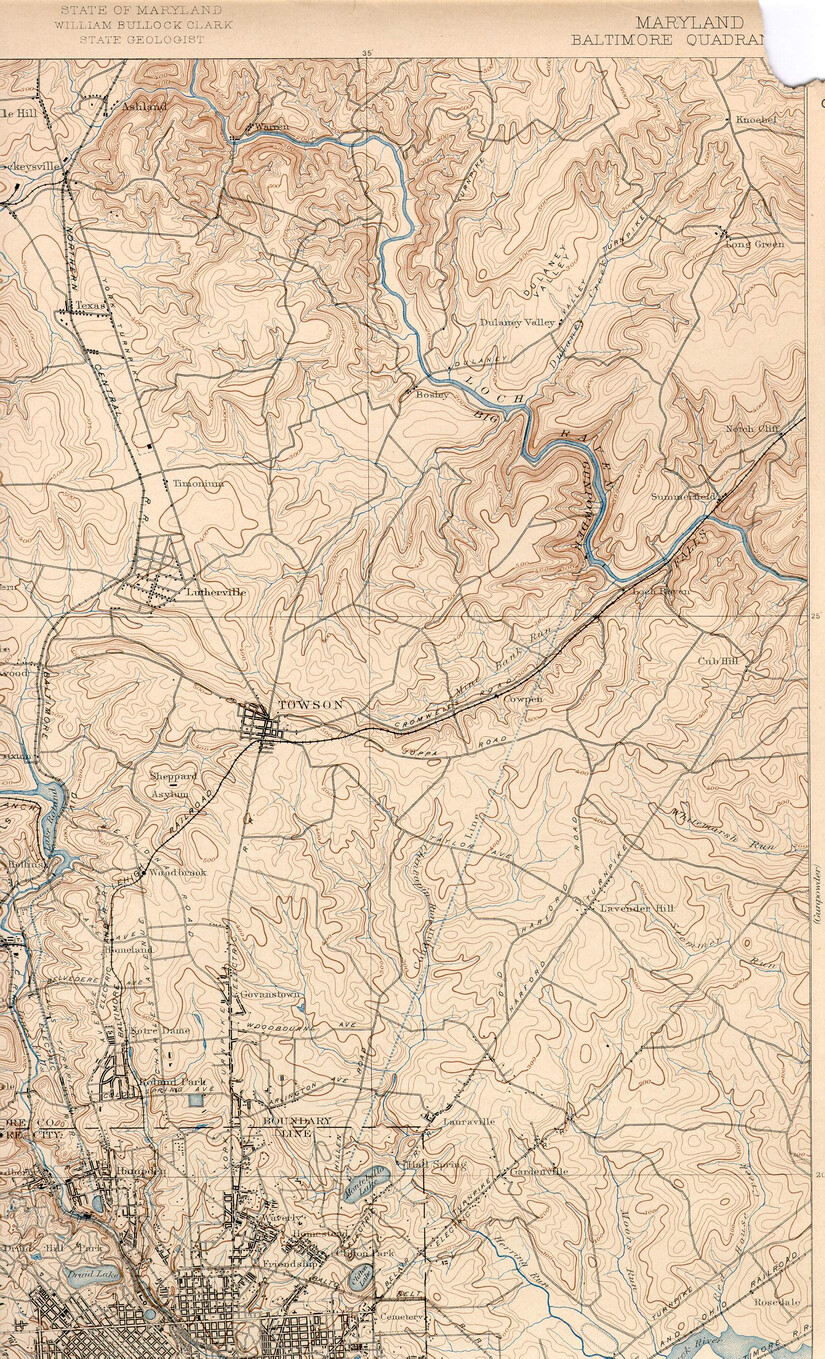Image

Area residents have long been enamored by the unique rail line that snaked its way through Harford County’s farms and fields delivering products between Pennsylvania and Baltimore. Walt Holloway is the Historical Society’s resident expert on the railroad and will share his numerous photos and stories of this legendary part of County history.
You can view the entire recent engaging presentation here. It is fascinating local history.

Craig Sansonetti, maandparailroad.com

The Maryland and Pennsylvania Railroad, affectionately known as the Ma & Pa, connected Baltimore and York, Pennsylvania, over a circuitous 77 mile route. Its earliest predecessor, the Maryland Central Railroad, was chartered in Maryland in 1867 for the purpose of building a Baltimore to Philadelphia line via Bel Air and Conowingo but laid no track. Joe (Kozlovsky) Kane a civil engineer with the CSX system felt that the straight part of Thomas Run Road was the original grade for this intended line. The first actual construction on the route of the Ma & Pa began in Pennsylvania with the Peach Bottom Railway which completed a narrow gauge line from York through Red Lion and Delta to Peach Bottom on the Susquehanna River between 1873 and 1876. This line was intended to be the middle division of a larger narrow gauge railroad connecting the East Broad Top coal fields of central Pennsylvania with Philadelphia, but no track was built west of York nor did the railroad succeed in crossing the Susquehanna River to connect with the few miles of track that were constructed on the east side.
The rural Maryland country northeast of Baltimore had to wait for several more years before it received the benefits of rail service. Three more companies followed the lead of the Maryland Central, obtaining charters to construct a railroad northeast from Baltimore but failing to build any track. Finally, in 1878, William Waters and other businessmen from Harford County consolidated the charters of several of these failed companies to form the Baltimore and Delta Railway. Their goal was a modest one, a local rail line that would carry milk and other agricultural products to markets in Baltimore and serve the Delta slate quarries. Because the promoters of the B&D hoped for interchange traffic with the Peach Bottom Railway at Delta, they followed its lead and built a narrow gauge line. In 1882 the B&D began operation from Baltimore to Towson and that same year merged into the still extant Maryland Central Railroad, which completed a line through Bel Air to Delta in 1884. Despite some financial difficulties the Maryland Central in 1887 erected a substantial stone station at Oak Street and North Avenue in Baltimore.

With the completion of the Maryland Central the two narrow gauge railroads began to exchange traffic at Delta. By 1889 the Maryland Central had gained control of the Pennsylvania line and through train service between Baltimore and York was initiated. Two years later the lines were merged to form the Baltimore and Lehigh Railroad with headquarters in Baltimore. By this time it had become apparent that the future for narrow gauge railroads was bleak, and the Baltimore and Lehigh entered into a contract to convert the railroad to standard gauge. The company was under capitalized, however, and was driven into bankruptcy by the depression of 1893.
The Maryland and Pennsylvania sections of the B&L were sold at separate receiver's auctions. The northern end was purchased by Warren Walworth of Cleveland who organized the York Southern Railroad while the southern end was controlled by John Wilson Brown, member of a prominent Baltimore banking family, who formed the Baltimore and Lehigh Railway. The York Southern had better freight prospects and stronger financing which permitted Walworth to proceed with conversion of the line to standard gauge. The conversion was completed in 1895, and the York Southern began to interchange freight cars with the Pennsylvania Railroad in York. Also in this period a short branch from the mainline near Yoe to Dallastown was built. The weaker Baltimore and Lehigh continued to operate as a narrow gauge line until 1901 when it contracted with the Sanford and Brooks Company to accomplish the conversion. During most of this period there was hostility between the two railroads, and no direct connections were offered in Delta.
In 1899, control of the York Southern was purchased by Sperry, Jones & Company of Baltimore. With both lines controlled by Baltimore interests, the stage was set for a final consolidation of the line. The unification was effected by the investment banking firm of Alexander Brown & Company which bought control of the B&L in early 1901. A plan of merger was developed and accepted by the stockholders of the B&L and the York Southern who exchanged their shares for shares in the newly formed Maryland & Pennsylvania Railroad. The new company was firmly in the hands of Maryland interests. Seven of the nine directors including John Wilson Brown, Alexander Brown, and John Cowen (General Counsel of the B&O) were from Baltimore. John Wilson Brown was named president of the line. With this new management came access to Baltimore capital markets for improvement of the line and a continuing relationship with Maryland Trust Company and Mercantile Trust and Deposit Company which served as Trustees for the company's bonds. These relationships with the Baltimore financial community provided the stability that allowed the Ma & Pa to weather the Great Depression without falling into bankruptcy.

With unification came an extended period of prosperity for the Ma & Pa. In these early years more than half the company's revenue came from passenger, mail, and express. These services were heavily concentrated on the Maryland District. From the beginning, the core of passenger service was the two northbound and two southbound mail trains that ran the length of the railroad. There was also a daily York to Delta round trip. But in Maryland an early morning train from Delta brought great quantities of milk into the city, and many local trains operated between Bel Air and Baltimore. At the peak of service, Bel Air had 16 trains a day providing commuter service and a late night return for theater goers. Large quantities of express were handled, especially at Bel Air and Towson. The railroad promoted the recreational possibilities along its route and many city dwellers took their families on Sunday outings to Loch Raven or the Rocks of Deer Creek. Passenger traffic totaled about 3 million passenger miles annually, an impressive total for a railroad on which the average trip certainly did not exceed 30 miles. The trains were a central feature of life for the agricultural communities all along the line.
Freight before World War I consisted primary of agricultural goods moving to market. From some stations, such as Fallston and Woodbine, full carloads of milk were moved daily. Wheat was shipped to market from local grain elevators such as those at Bel Air and Muddy Creek Forks, and canneries at many stations including Hyde, Bynum, and High Rock were a substantial source of traffic. Despite the seasonal nature of the canning business, 12% of freight revenue in 1907 came from cannery shipments. The balance of freight originating on the line was slate from Delta and light manufactured goods from Red Lion and Dallastown. Incoming shipments were primarily coal, fertilizer, and less than carload shipments of goods to merchants along the route.
Although the railroad was showing substantial operating surpluses, it paid no dividends preferring to improve its facilities. Numerous locomotives and passenger cars were purchased to handle the booming business. All of the bridges and trestles were strengthened, heavier rail was installed, and the major wooden trestles between Baltimore and Bel Air were replaced with steel viaducts. New stations were built at Fallston, Baldwin, Glenarm, and Forest Hill where the original station in the Roe and Tucker General Store was destroyed by fire. Major track relocations were made between the Little Gunpowder River and Laurel Brook in Harford County and just north of Laurel on the Pennsylvania District to reduce excessive curvature. In 1907 the railroad began a major expansion of its Baltimore terminal facilities building over the next few years a direct connection to the Baltimore & Ohio Railroad, new yard tracks, extensive coal docks, a large stone roundhouse and shop which still stands along Falls Road, and a new freight station.
The Ma & Pa served almost no industrial shippers in Baltimore, its line running through residential areas, but the city was undoubtedly its center of operations. The railroad's general offices were in Baltimore, all train dispatching was located there, and equipment maintenance was centered in the city. In its Baltimore shops the Ma & Pa did all of the maintenance for its 16 active steam locomotives, maintained its passenger cars, and built many of its own freight cars. At its peak in 1913 the Ma & Pa had 573 employees with the greatest concentration in Baltimore.
After World War I the pattern of traffic on the railroad began to change. With improved roads and more cars passenger traffic dropped rapidly. By 1936 passenger train operations had fallen to 10% of the railroad's revenues. Service was reduced to the mail trains, and the passengers that remained were mostly in Pennsylvania where no roads paralleled the railroad through the Muddy Creek Valley. Milk and less than carload freight were lost to trucks, and coal revenues decreased as fewer homes used coal for heating. Manufactured goods from Red Lion and York and slate from Delta and Whiteford became the mainstay of the railroad. With these changes the dominant position of the Maryland District began to fade.
In 1935 the Ma & Pa became a pioneer in a new type of railroad operation that was never a significant source of revenue but brought national and international fame to the line. Under the sponsorship of the Baltimore Society of Model Engineers the Ma & Pa ran its first railfan excursion. The trip was coordinated by A. M. Bastress, traffic manager of the Ma & Pa. President O. H. Nance made the trip himself, catering to the whims of the railfans with photo stops and rides in the cab of the steam locomotive. Many other railfan excursions followed over the next dozen years including NRHS sponsored circle trips from Philadelphia over the Pennsylvania Railroad and the Ma & Pa. As a result of these excursions and the press coverage they received the Ma & Pa became one of the best known short lines in the United States, famous for its beautiful scenery and its antique equipment.
By the 1950's passengers had dwindled to about 12 per train and it was clear that only the government contract for operating the Railway Post Office cars was keeping the passenger trains going. In 1954 the postal contract was lost to a trucking company, and on August 31st the last passenger train ran. Freight traffic on the Maryland District had declined to such an extent that through freight trains were no longer run. Daily service between York and Delta was supplemented by trains as needed from Baltimore that ran only as far north as the traffic required. In 1958 the Maryland District was abandoned and the Ma & Pa moved its offices to York.
The Pennsylvania District survived for another two decades. Slate and green marble from Delta and Cardiff, furniture and manufactured goods from Red Lion and Dallastown, and switching to many industries along the line in York permitted operations at a break even level. In the late 60's construction of the Peach Bottom Nuclear Power Plant brought a significant temporary increase in traffic. The fate of the Pennsylvania District was sealed by the end of slate quarrying at Delta in 1971. The last revenue train to Whiteford ran in 1978 and service to Red Lion was ended in 1984. The Maryland & Pennsylvania Railroad survives as a switching railroad in York and now operates to Hanover over the former Pennsylvania Railroad right of way, but the current company has little in common with the historic Ma & Pa.
In 1986 and 1987 the track of the original Pennsylvania District south of York was dismantled. Only an eight mile segment between Laurel and Bridgeton was left in place. This section was acquired by the Maryland & Pennsylvania Railroad Preservation Society which has since labored to restore it to operable condition in hopes of returning excursion trains to the Muddy Creek Valley.